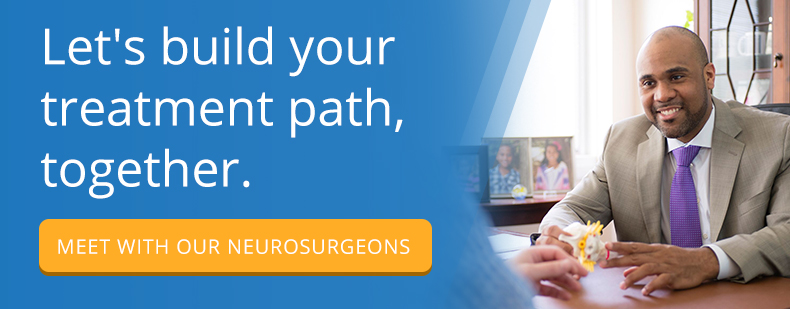Chiari malformations are typically developmental, which means they form as your body grows prior to birth. However, many patients are asymptomatic until adulthood and do not receive treatment until they are older. For adult patients with symptomatic Chiari malformations that do not respond to non-surgical treatment, there are several surgical options available.
Your condition may necessitate one treatment over another. Your surgeon will likely recommend what he or she feels is best for you, but understanding the different options available allows you to make informed decisions about your health when the time comes to opt for or consent to a procedure.
About Chiari Malformation
A helpful way to understand your Chiari malformation treatment is to learn about its cause. Your skull forms a protective covering for the brain, and the two generally fit perfectly together. This is because they grow together, and the bone forms curves and grooves to accommodate your growing brain.
In some people, the skull does not grow quite as much as it should. Because the brain is easily deformed, it gets pushed down through an opening in the skull called the foramen magnum. This is where the spinal cord leaves the head and courses down your spine, protected by vertebrae.
When that area of the brain, called the cerebellar tonsils, gets pushed into the foramen magnum, it blocks the space. This prevents the flow of cerebrospinal fluid (CSF), a specialized liquid that surrounds and cushions the brain and spinal cord and can cause direct compression of the brain stem or spinal cord. This causes an increase in pressure, leading to the symptoms and/or damage you may be experiencing.
Traditional vs. Minimally Invasive Treatments
When it comes to Chiari malformation treatment, there are generally two approaches a surgeon may use: traditional surgery or minimally invasive. Traditional surgical procedures are what you would think of as open surgery and include Chiari decompression surgery and cervical laminectomies, which have been used by many doctors to effectively treat Chiari malformation patients. However, new advances in technology and techniques have made minimally invasive Chiari malformation treatments possible. In a minimally invasive surgery, the surgeon uses specialized instruments that allow him or her to make smaller incisions and disrupt less of the surrounding tissues.
Most patients who are candidates for traditional Chiari malformation surgery are also eligible for minimally invasive approaches. In fact, many Chiari malformation specialists have come to prefer using minimally invasive treatments because they are just as effective as traditional surgery, with increased benefits to patients.
As a patient, minimally invasive treatments means that you can expect to experience less bleeding, less pain and a shorter recovery period. Your hospital stay following a minimally invasive Chiari malformation procedure will typically be shorter than traditional open surgery. You will likely require less pain medication and/or need medication over a shorter duration. You may also be able to return to work and resume your normal activities more quickly, although recovery is a very individual process and varies from patient to patient.
Chiari Malformation Treatments for Adults
Although there are different treatment options to resolve a Chiari malformation, they each have a common treatment goal. In one way or another, they increase the space for the cerebellum and/or spinal cord or the CSF, thereby relieving the pressure that has built up.
Decompression
One of the most commonly used procedures is decompression, which increases the space for the cerebellum and restores CSF flow. The surgeon will typically enter through an incision at the back of your neck and remove a small section at the back of your skull. Then he or she carefully opens a section of dura, the thin membrane that covers your brain, and expands it with a special patch harvested from your tissues or another source.
This procedure usually requires 2-4 days in the hospital following surgery, during which your healthcare team will monitor you and your recovery. You can expect to be on physical restrictions afterward, which may include driving restrictions.
Minimally Invasive Decompression
There are some neurosurgery practices that offer minimally invasive Chiari decompression surgery. Because of recent technological innovations and specialized training, the surgeon can use microscopic visualization and special tools to perform a surgery with a smaller incision site and no use of a patch. Most patients will also experience reduced healing time, reduced pain and less time in the hospital compared to traditional decompression surgery.
Cervical Laminectomy
Cervical laminectomy is often used in conjunction with the above procedures where in addition to, removing a piece of your skull, your surgeon will also remove part your uppermost vertebrae, creating more space around the spinal cord. When used with decompression surgery, it increases the space for both the cerebellum and spinal cord, thereby relieving pressure.
Transnasal/transoral Decompression
In rare cases, some patients will require another type of decompression surgery, called transnasal/transoral decompression. The neurosurgeon will approach from the front of the skull, either through the nose or mouth, and will remove a section of bone. This procedure is reserved for patients who have additional skull base deformities.
Spinal Fusion
In some cases, a Chiari malformation can be found in conjunction with spinal instability (for example: patients with connective tissue disorders such as Ehlers-Danlos). If there is demonstrable spinal instability pre-operatively, the surgeon may decide to increase the stability of the head and neck to protect the spinal cord. This procedure is typically performed as an adjunct therapy in addition to the primary Chiari malformation treatment. The surgeon places special permanent instrumentation into the skull and upper vertebrae, along with bone fusion material, to encourage the bones to heal together into a single unit.
In addition to the recovery from any other Chiari malformation treatment, spinal fusion recovery typically requires that you wear a neck brace for a period of time to help limit range of motion. You may also benefit from physical therapy during and after your recovery to maximize your range of motion after healing.
CSF (Cerebrospinal Fluid) Diversion
CSF diversion is a way to treat the buildup of cerebrospinal fluid itself by implanting a tube and diverting the fluid to another area of the body. Permanent diversion of fluid is typically shunted into the abdomen, where the CSF can be reabsorbed into the bloodstream. Because this procedure resolves increased intracranial pressure quickly, some patients experience relief from symptoms immediately, though this varies on an individual basis.
The Right Treatment for You
As an adult Chiari malformation patient, it is likely that your surgeon has already recommended a treatment that he or she feels is most appropriate for you. There are a number of factors your doctor has taken into consideration before recommending one Chiari malformation treatment over another and these are individual to you and your condition. These can include your previous health history, prescription medications you may be taking, your age and your weight.
For some patients, traditional surgical options carry increased risks. If you have a complicating health condition or are an older patient, traditional surgery may not be a viable choice. However, some patients who do not qualify for traditional surgical methods may still be candidates for minimally invasive treatment approaches.
If your doctor has not presented minimally invasive Chiari malformation treatment as an option, you may wish to consider consulting with a Chiari malformation specialist. Not every practice will have doctors trained in minimally invasive approaches, so it will not always be offered as a possibility.
Now that you have learned more about the Chiari malformation treatment options available to you, you can more confidently discuss any questions or concerns that you may have. Your health care team wants you to be comfortable before, during and after your procedure. They will be happy to address any issues so you have peace of mind and can focus on recovery.


